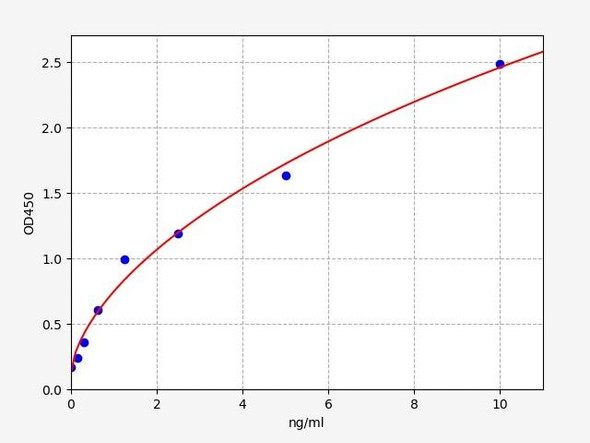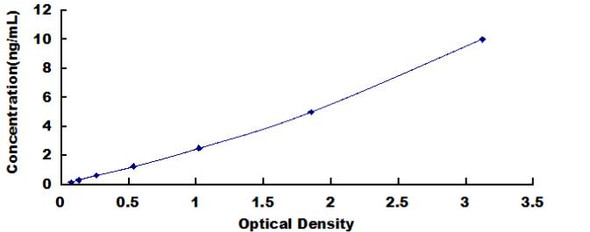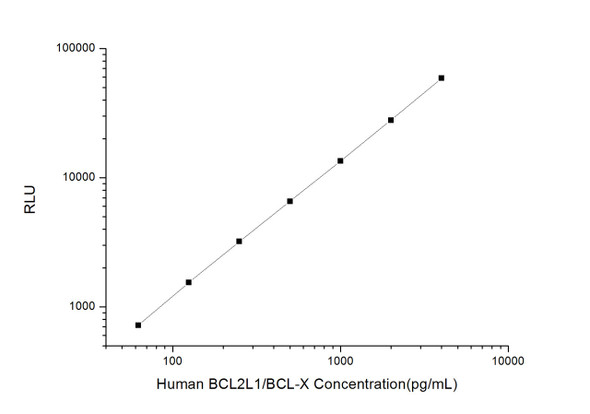Human Cell Death ELISA Kits
Human BAG3 (Bcl2 Associated Athanogene 3) CLIA Kit (HUES00300)
- SKU:
- HUES00300
- Product Type:
- ELISA Kit
- ELISA Type:
- CLIA Kit
- Size:
- 96 Assays
- Sensitivity:
- 18.75pg/mL
- Range:
- 31.25-2000pg/mL
- ELISA Type:
- Sandwich
- Synonyms:
- BAG-3, BIS, CAIR-1, BAG family molecular chaperone regulator 3
- Reactivity:
- Human
- Sample Type:
- Serum, plasma and other biological fluids
- Research Area:
- Cell Death
Description
| Assay type: | Sandwich |
| Format: | 96T |
| Assay time: | 4.5h |
| Reactivity: | Human |
| Detection method: | Chemiluminescence |
| Detection range: | 31.25-2000 pg/mL |
| Sensitivity: | 18.75 pg/mL |
| Sample volume: | 100µL |
| Sample type: | Serum, plasma and other biological fluids |
| Repeatability: | CV < 15% |
| Specificity: | This kit recognizes Human BAG3 in samples. No significant cross-reactivity or interference between Human BAG3 and analogues was observed. |
This kit uses Sandwich-CLIA as the method. The micro CLIA plate provided in this kit has been pre-coated with an antibody specific to Human BAG3. Standards or samples are added to the appropriate micro CLIA plate wells and combined with the specific antibody. Then a biotinylated detection antibody specific for Human BAG3 and Avidin-Horseradish Peroxidase (HRP) conjugate are added to each micro plate well successively and incubated. Free components are washed away. The substrate solution is added to each well. Only those wells that contain Human BAG3, biotinylated detection antibody and Avidin-HRP conjugate will appear fluorescence. The Relative light unit (RLU) value is measured spectrophotometrically by the Chemiluminescence immunoassay analyzer. The RLU value is positively associated with the concentration of Human BAG3. The concentration of Human BAG3 in the samples can be calculated by comparing the RLU of the samples to the standard curve.
| UniProt Protein Function: | BAG3: Inhibits the chaperone activity of HSP70/HSC70 by promoting substrate release. Has anti-apoptotic activity. Defects in BAG3 are the cause of myopathy myofibrillar type 6 (MFM6). A neuromuscular disorder that results in early-onset, severe, progressive, diffuse muscle weakness associated with cardiomyopathy, severe respiratory insufficiency during adolescence, and a rigid spine in some patients. At ultrastructural level, muscle fibers display structural alterations consisting of replacement of the normal myofibrillar markings by small, dense granules, or larger hyaline masses, or amorphous material. Defects in BAG3 are the cause of cardiomyopathy dilated type 1HH (CMD1HH). CMD1HH is a disorder characterized by ventricular dilation and impaired systolic function, resulting in congestive heart failure and arrhythmia. Patients are at risk of premature death. |
| UniProt Protein Details: | Protein type:Apoptosis Chromosomal Location of Human Ortholog: 10q26. 11 Cellular Component: cell-cell adherens junction; cytoplasm; cytosol; plasma membrane Molecular Function:adenyl-nucleotide exchange factor activity; protein binding Biological Process: induction of apoptosis via death domain receptors Disease: Cardiomyopathy, Dilated, 1hh; Myopathy, Myofibrillar, 6 |
| NCBI Summary: | BAG proteins compete with Hip for binding to the Hsc70/Hsp70 ATPase domain and promote substrate release. All the BAG proteins have an approximately 45-amino acid BAG domain near the C terminus but differ markedly in their N-terminal regions. The protein encoded by this gene contains a WW domain in the N-terminal region and a BAG domain in the C-terminal region. The BAG domains of BAG1, BAG2, and BAG3 interact specifically with the Hsc70 ATPase domain in vitro and in mammalian cells. All 3 proteins bind with high affinity to the ATPase domain of Hsc70 and inhibit its chaperone activity in a Hip-repressible manner. [provided by RefSeq, Jul 2008] |
| UniProt Code: | O95817 |
| NCBI GenInfo Identifier: | 12643665 |
| NCBI Gene ID: | 9531 |
| NCBI Accession: | O95817. 3 |
| UniProt Secondary Accession: | O95817,Q3B763, Q9NT20, Q9P120, A8K5L8, |
| UniProt Related Accession: | O95817 |
| Molecular Weight: | 61,595 Da |
| NCBI Full Name: | BAG family molecular chaperone regulator 3 |
| NCBI Synonym Full Names: | BCL2 associated athanogene 3 |
| NCBI Official Symbol: | BAG3 |
| NCBI Official Synonym Symbols: | BIS; MFM6; BAG-3; CAIR-1 |
| NCBI Protein Information: | BAG family molecular chaperone regulator 3 |
| UniProt Protein Name: | BAG family molecular chaperone regulator 3 |
| UniProt Synonym Protein Names: | Bcl-2-associated athanogene 3; Bcl-2-binding protein Bis; Docking protein CAIR-1 |
| Protein Family: | BAG family molecular chaperone regulator |
| UniProt Gene Name: | BAG3 |
As the RLU values of the standard curve may vary according to the conditions of the actual assay performance (e. g. operator, pipetting technique, washing technique or temperature effects), the operator should establish a standard curve for each test. Typical standard curve and data is provided below for reference only.
| Concentration (pg/mL) | RLU | Average | Corrected |
| 2000 | 53480 57962 | 55721 | 55693 |
| 1000 | 21788 26160 | 23974 | 23946 |
| 500 | 11801 10263 | 11032 | 11004 |
| 250 | 5229 5359 | 5294 | 5266 |
| 125 | 2800 2416 | 2608 | 2580 |
| 62.5 | 1400 1222 | 1311 | 1283 |
| 31.25 | 645 703 | 674 | 646 |
| 0 | 27 29 | 28 | -- |
Precision
Intra-assay Precision (Precision within an assay): 3 samples with low, mid range and high level Human BAG3 were tested 20 times on one plate, respectively.
Inter-assay Precision (Precision between assays): 3 samples with low, mid range and high level Human BAG3 were tested on 3 different plates, 20 replicates in each plate.
| Intra-assay Precision | Inter-assay Precision | |||||
| Sample | 1 | 2 | 3 | 1 | 2 | 3 |
| n | 20 | 20 | 20 | 20 | 20 | 20 |
| Mean (pg/mL) | 95.00 | 180.60 | 975.47 | 93.66 | 179.48 | 1051.19 |
| Standard deviation | 8.06 | 13.17 | 69.26 | 8.80 | 17.01 | 79.79 |
| C V (%) | 8.48 | 7.29 | 7.10 | 9.40 | 9.48 | 7.59 |
Recovery
The recovery of Human BAG3 spiked at three different levels in samples throughout the range of the assay was evaluated in various matrices.
| Sample Type | Range (%) | Average Recovery (%) |
| Serum (n=5) | 92-108 | 99 |
| EDTA plasma (n=5) | 88-103 | 95 |
| Cell culture media (n=5) | 99-113 | 107 |
Linearity
Samples were spiked with high concentrations of Human BAG3 and diluted with Reference Standard & Sample Diluent to produce samples with values within the range of the assay.
| Serum (n=5) | EDTA plasma (n=5) | Cell culture media (n=5) | ||
| 1:2 | Range (%) | 85-97 | 94-108 | 101-118 |
| Average (%) | 91 | 102 | 108 | |
| 1:4 | Range (%) | 86-100 | 101-120 | 91-106 |
| Average (%) | 92 | 109 | 98 | |
| 1:8 | Range (%) | 91-104 | 90-102 | 92-105 |
| Average (%) | 98 | 96 | 99 | |
| 1:16 | Range (%) | 90-105 | 90-105 | 98-112 |
| Average (%) | 97 | 97 | 104 |
An unopened kit can be stored at 4°C for 1 month. If the kit is not used within 1 month, store the items separately according to the following conditions once the kit is received.
| Item | Specifications | Storage |
| Micro CLIA Plate(Dismountable) | 8 wells ×12 strips | -20°C, 6 months |
| Reference Standard | 2 vials | |
| Concentrated Biotinylated Detection Ab (100×) | 1 vial, 120 µL | |
| Concentrated HRP Conjugate (100×) | 1 vial, 120 µL | -20°C(shading light), 6 months |
| Reference Standard & Sample Diluent | 1 vial, 20 mL | 4°C, 6 months |
| Biotinylated Detection Ab Diluent | 1 vial, 14 mL | |
| HRP Conjugate Diluent | 1 vial, 14 mL | |
| Concentrated Wash Buffer (25×) | 1 vial, 30 mL | |
| Substrate Reagent A | 1 vial, 5 mL | 4°C (shading light) |
| Substrate Reagent B | 1 vial, 5 mL | 4°C (shading light) |
| Plate Sealer | 5 pieces | |
| Product Description | 1 copy | |
| Certificate of Analysis | 1 copy |
- Set standard, test sample and control (zero) wells on the pre-coated plate and record theirpositions. It is recommended to measure each standard and sample in duplicate. Note: addall solutions to the bottom of the plate wells while avoiding contact with the well walls. Ensuresolutions do not foam when adding to the wells.
- Aliquot 100µl of standard solutions into the standard wells.
- Add 100µl of Sample / Standard dilution buffer into the control (zero) well.
- Add 100µl of properly diluted sample (serum, plasma, tissue homogenates and otherbiological fluids. ) into test sample wells.
- Cover the plate with the sealer provided in the kit and incubate for 90 min at 37°C.
- Aspirate the liquid from each well, do not wash. Immediately add 100µL of BiotinylatedDetection Ab working solution to each well. Cover the plate with a plate seal and gently mix. Incubate for 1 hour at 37°C.
- Aspirate or decant the solution from the plate and add 350µL of wash buffer to each welland incubate for 1-2 minutes at room temperature. Aspirate the solution from each well andclap the plate on absorbent filter paper to dry. Repeat this process 3 times. Note: a microplatewasher can be used in this step and other wash steps.
- Add 100µL of HRP Conjugate working solution to each well. Cover with a plate seal andincubate for 30 min at 37°C.
- Aspirate or decant the solution from each well. Repeat the wash process for five times asconducted in step 7.
- Add 100µL of Substrate mixture solution to each well. Cover with a new plate seal andincubate for no more than 5 min at 37°C. Protect the plate from light.
- Determine the RLU value of each well immediately.






